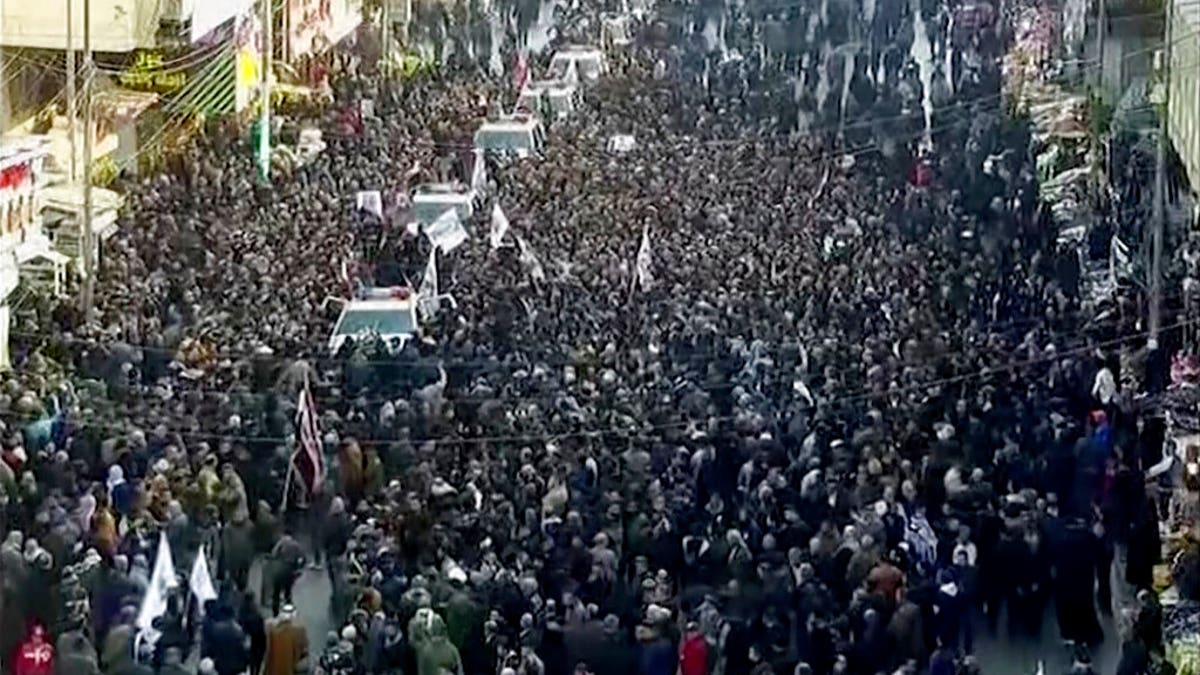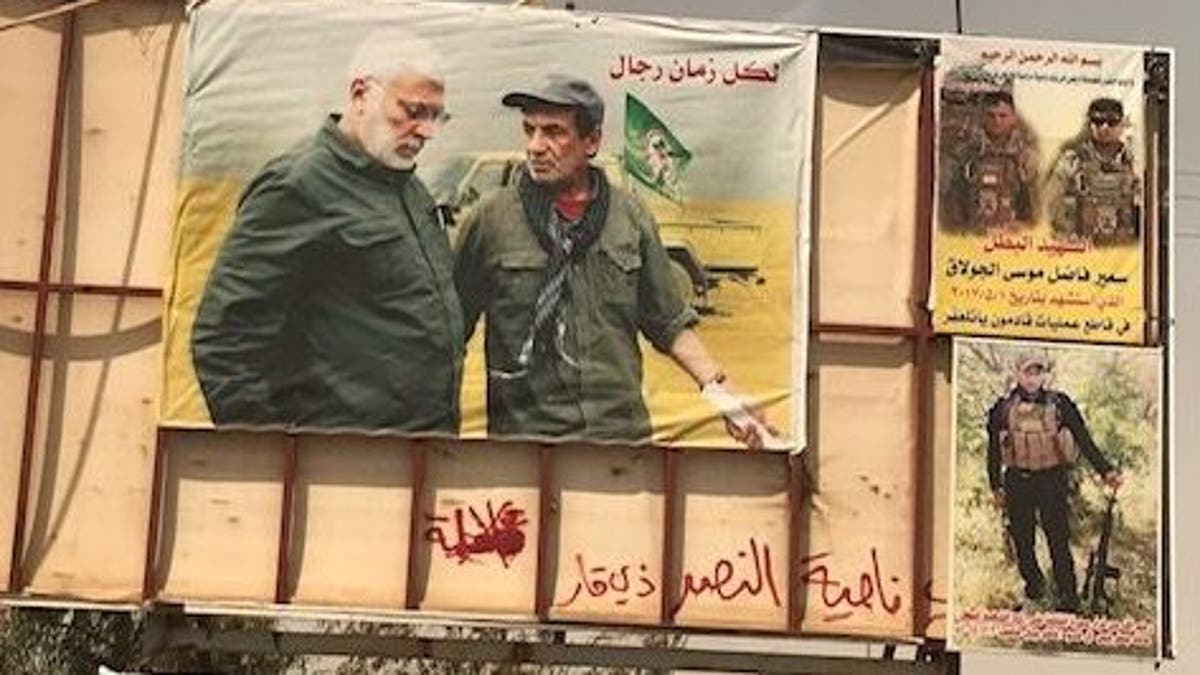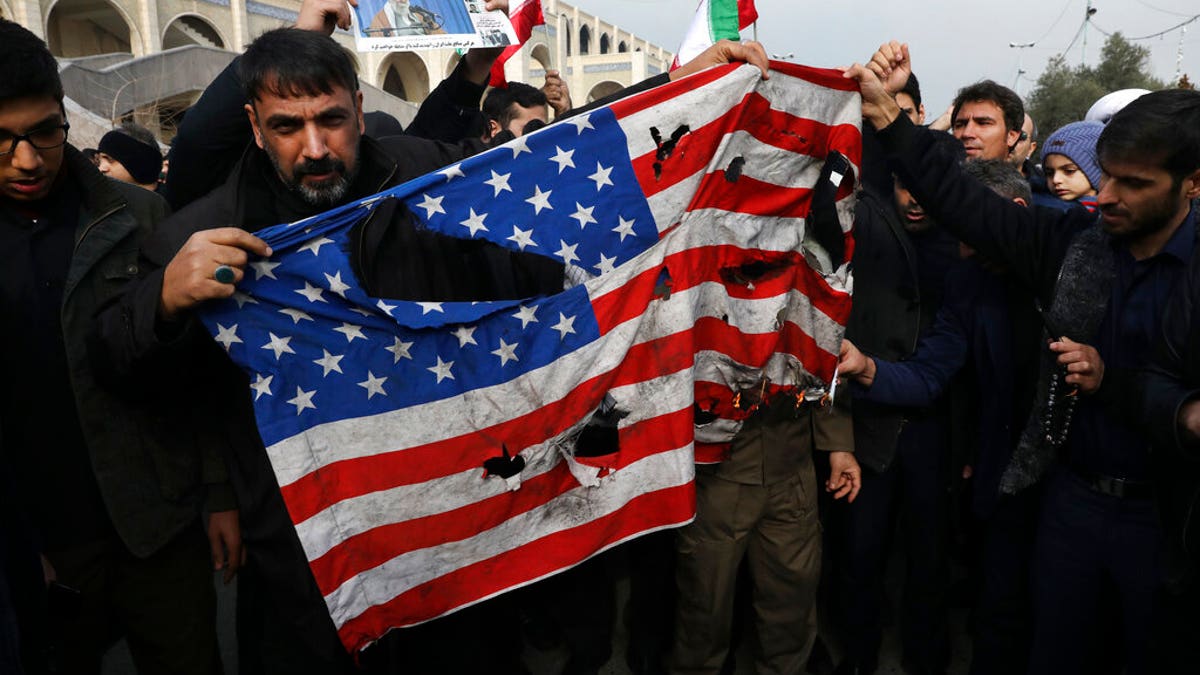Former acting CIA director warns Iran will kill Americans after Soleimani strike
Iran vows retaliation; Lt. Col. Daniel Davis, Walid Phares, and Rep. Mark Green react.
For years, Iranian general Qassem Soleimani was viewed as military royalty among his tens of thousands of followers in the Popular Mobilization Forces in Iraq.
His picture adorned billboards of cities liberated from ISIS, and militia commanders boasted about their battlefield selfies with him and trips into Iran and Syria aboard his private aircraft. He was combat-hardened and untouchable – or so he may have thought.
Before dawn Friday, a U.S. MQ-9 Reaper drone fired missiles into a convoy carrying Soleimani, soon after his arrival at the Baghdad international airport. Photographs of his charred skeleton quickly surfaced, along with a flurry of questions in America and around the world.
Top U.S. officials on both sides of the aisle say they were blindsided by the move. They are demanding answers about the extreme secrecy shrouding the planning of the attack and its potential consequences.
“We had no awareness, no indication; we were not informed and knew nothing until after it happened,” one high-ranking Baghdad official told Fox News.
AFTER SOLEIMANI: CELEBRATIONS, CYBER-ATTACKS, AND THREATS TO KICK US TROOPS OUT OF IRAQ
Soleimani had long been deemed an enemy of the United States with American blood on his hands, and no U.S.officials or political leaders mourned his demise.
But the drone strike, signed off on by President Donald Trump, immediately sparked threats of severe reprisals by Iran, pushing the U.S. to the brink of war.

In this Thursday, Feb. 11, 2016, file photo, Qassem Soleimani, commander of Iran's Quds Force, attends an annual rally commemorating the anniversary of the 1979 Islamic revolution, in Tehran, Iran. Iraqi TV and three Iraqi officials said Friday, Jan. 3, 2020, that Gen. Qassem Soleimani, the head of Iran’s elite Quds Force, has been killed in an airstrike at Baghdad’s international airport. (AP)
Knowing at least some of the likely fallout, why target Soleimani now?
Secretary of State Mike Pompeo said the strike sought to curb an “imminent attack” that threatened Americans in the region, including diplomats and troops. He told Fox News on Friday that it was an “intelligence-based assessment.”
A source who worked closely with officials in shaping U.S Syria policy said there were indications that a Soleimani-designed attack was looming.
“He was working to destroy U.S. interests in many countries, pushing for a new government in Iraq more friendly to Iran and destroy the reputation of Trump,” the source said.
Yet many Washington insiders and defense experts remain skeptical about whether those attacks were truly imminent.
“I believe we have had plans [to eliminate Soleimani] all along. The attack on the U.S. embassy was the trigger to get that ball rolling,” said a former Pentagon official and Middle East expert, who spoke on background.
NY TIMES REPORTER'S TWEET OF SOLEIMANI RECITING POETRY DRAWS BACKLASH
The drone attack also killed Soleimani adviser Abu Mahdi al-Muhandis, whose militia has been linked to the attacks less than a week ago that killed an American contractor in Kirkuk.
According to Jenna Ben-Yehuda, president of the Truman National Security Project and a former State Department official who worked with the Defense Department, the lead-up to Soleimani’s slaying under the Trump banner has been building for some time – starting with Trump's decision to pull out of the Iran nuclear deal in May 2018.

In this image made from a video, mourners gather for a funeral procession for Gen. Qassem Soleimani, in Baghdad Saturday, Jan. 4, 2020. The head of Iran's elite Quds force and mastermind of its regional security strategy, was killed in an airstrike early Friday near the Iraqi capital's international airport that has caused regional tensions to soar. (PMF Media Office via AP)
“Then his move to designate the Islamic Revolutionary Guard Corps as a terrorist organization in April 2019, the first time the U.S. has ever given that designation to an element of a foreign government, makes Thursday's attack part of a destabilizing chain of events,” she said.
“While Secretary of State Pompeo has asserted that the U.S. made the decision to strike on Thursday in response to ‘imminent threats’ against U.S. personnel and assets, the fact that he appears not to have provided the public, Congress, or allies with additional information about those threats casts doubts on the veracity of his claim,” Ben-Yehuda added.
WASHINGTON POST BLASTED FOR REFERRING TO QASSIM SOLEIMANI AS IRAN'S 'MOST REVERED MILITARY LEADER'
Kenneth Pollack, a Middle East expert at the American Enterprise Institute, believes the decision to go ahead with the strike came down to having reliable intelligence – where the target would be and when – and little risk to civilian lives.
“We know Qassem may have been planning an attack in general terms, but we don’t know about when and how. I would say we got an intel hit. He was going to be at the airport, on a VIP access road, late at night when civilians were not around and an easy target,” Pollack said. “The opportunity was too good to pass up.”
On Friday, former National Security Advisor John Bolton suggested that the operation was not a last-minute decision.
“Long in the making, this was a decisive blow against Iran's malign Quds Force activities worldwide,” he tweeted. “Hope this is the first step to regime change in Tehran.”
Luke Coffey, director of the Allison Center for Foreign Policy at the Heritage Foundation, said it is likely that the U.S. was just waiting for the right opportunity to strike.
“For years, Soleimani has been wreaking havoc across the Middle East. He has American blood dripping from his hands. It was inevitable that he would meet his fate in this manner someday,” he said.

A poster of Qassem Soleimani adorns the entrance of the Iraqi city of Tel Afar in the months after it was liberated from ISIS. (Fox News/Hollie McKay)
While the Pentagon has remained mum on details of the strike, Iranian media reported that Soleimani had just touched down after a flight from Lebanon. Soleimani was certainly no stranger to Iraq, which borders Iran. He was routinely spotted with officials in Baghdad, and periodically visited the northern Kurdish region to discuss border security and military issues.
Soleimani is believed to have evaded several assassination attempts at the hands of Western, Israeli, and Saudi-connected operatives in recent decades. Both the Bush and Obama administrations passed up other opportunities to kill him, out of concern for retaliation and an escalation of Middle East tensions.
Multiple sources in Iraq indicated that Soleimani was well aware that the U.S. had passed on previous chances to kill him, perhaps fueling his feelings of invincibility.
Unlike other wanted men and terrorist leaders who spent their final years in hiding, Soleimani's actions seemed brazen – even personally joining battles to liberate Christian areas from ISIS in Syria – a move calculated to build popular support. The fact that Soleimani and al-Muhandis – two major figureheads – were traveling together shows their level of comfort in Iraq.
While the calculus from the White House is that the killing of the ruthless commander will scare Tehran into toeing the line, there is no way to predict the ramifications across Iraq and beyond.
Last year, the Trump administration officially designated Iran’s military, the Islamic Revolutionary Guard Corps, as a terrorist organization. Iran responded by branding all American troops terrorists. The State Department-issued label also came with expanded authorities to hone in on Iranian assets on Iraqi soil, but the elite Quds Force unit – Iran’s global intelligence wing and run by Soleimani – first received the terror tag in 2007.
While the 62-year-old Soleimani had been a favorite child of the clerical regime since the bitter Iran-Iraq war of the 1980s and climbed into the top commander position in 1998, his face was not known publically until around 2013 when Iran took on a prominent role fighting on behalf of President Bashar al-Assad next door in Syria.

Protesters burn a U.S. flag during a demonstration over the U.S. airstrike in Iraq that killed Iranian Revolutionary Guard Gen. Qassem Soleimani, in Tehran, Iran, Jan. 3, 2020. (AP)
One high-ranking defense official, who works closely with the U.S. military, said the assassination came as a shock, and even after the news broke, efforts to acquire further information about the strike were met with radio silence.
“Trump made the decision in secrecy, and we condemn it,” the official lamented.
But others said action to neutralize Soleimani had to be taken quickly because Iran’s dominance in Iraq was reaching a critical danger point.
“The recent protests and even attacks on the U.S. Embassy in Iraq, controlled and coordinated by Iran and having under its command Kata’ib Hezbollah, was a clear show of the starting of a wave of direct attacks against U.S. and allied strategic interests, which began with the Iranian-sponsored attack on an Iraqi base that killed an American contractor and wounded American troops,” said Johan Obdola, president of the Canada-based Global Organization for Intelligence. “It is obvious Iran is planning other major attacks against the U.S.”
“The tensions between Washington and Tehran have been rising for months, but the recent incidences in Iraq – the death of a U.S. contractor in Kirkuk and the attack against the U.S. embassy in particular probably contributed significantly to the U.S. decision to go after Soleimani directly,” said Naysan Rafati, an Iran analyst for the International Crisis Group.
